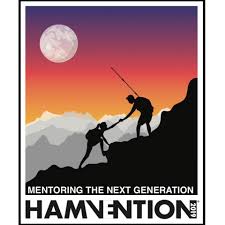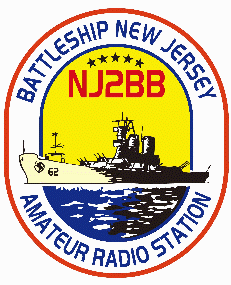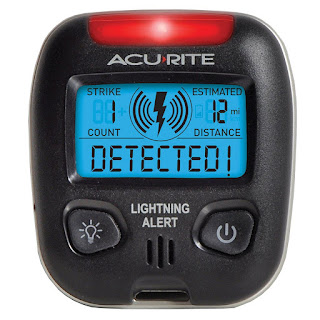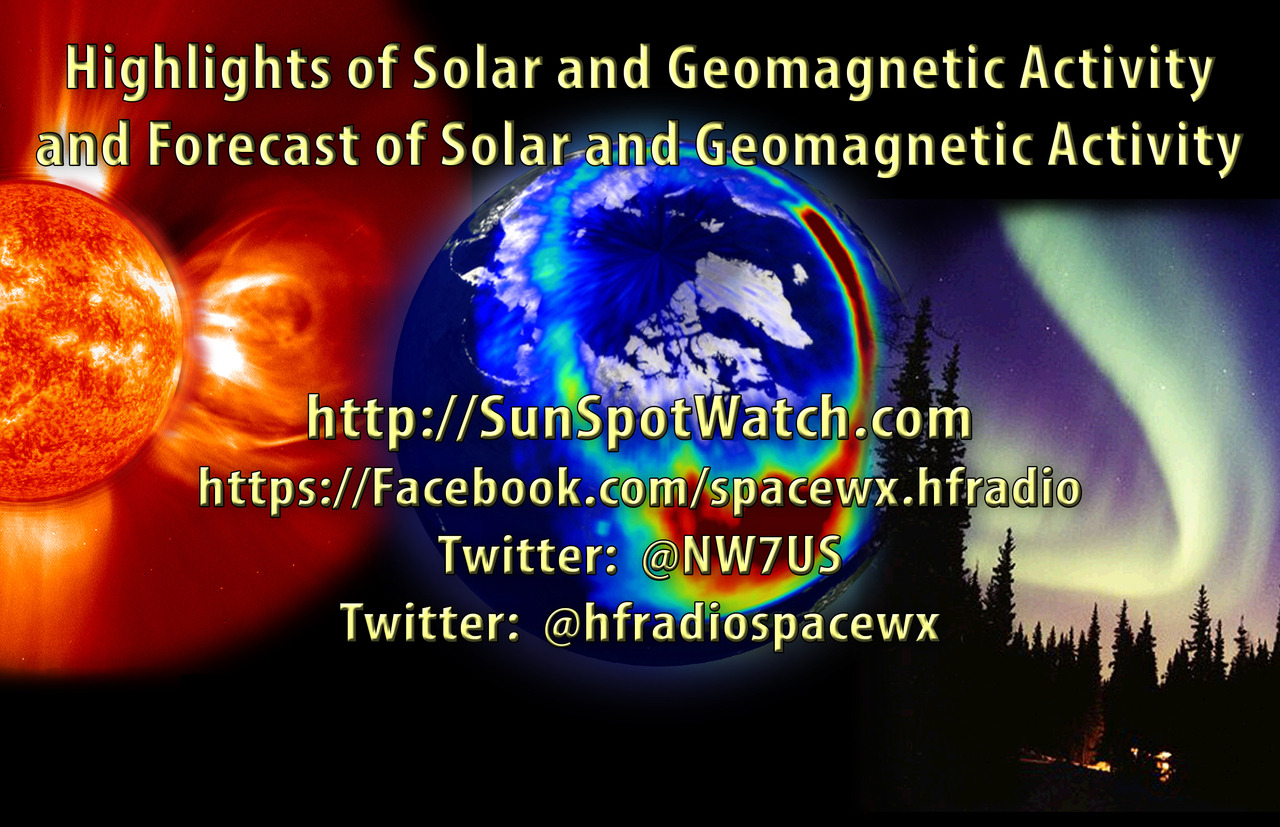 Weekly Propagation Summary – 2019 Jun 03 16:10 UTC
Weekly Propagation Summary – 2019 Jun 03 16:10 UTC
Here is this week’s space weather and geophysical report, issued 2019 Jun 03 0154 UTC.
Highlights of Solar and Geomagnetic Activity 27 May – 02 June 2019
Solar activity was at very low levels. No sunspots were observed on the visible disk. The strongest flare of the period reached B2 at 01/1454 UTC and was from around the E. limb. No Earth-directed CMEs were observed in available coronagraph imagery.
No proton events were observed at geosynchronous orbit.
The greater than 2 MeV electron flux at geosynchronous orbit was at normal levels on 27-28 May, moderate levels on 29 May and moderate to high levels on 31 May – 02 Jun. The increase in electron flux was due to increased solar wind speeds from a negative polarity CH HSS.
Geomagnetic field activity ranged from quiet to active levels. A weak, slow-moving transient was observed on 27 May, resulting in quiet to unsettled conditions. Total magnetic field strength reached a peak of 12 nT and no significant periods of southward Bz were observed. Solar wind speeds for the transient were between 320-380 km/s. Late on 28 May, an increase in solar winds to between 500-550 km/s was observed, producing unsettled conditions through 29 May, with an isolated period of active during the 29/0300-0600 synoptic period. The geomagnetic field returned to quiet levels after 30/0300 UTC as effects from the negative polarity CH HSS slowly waned. Quiet conditions were observed for the remainder of the reporting period.
Forecast of Solar and Geomagnetic Activity 03 June – 29 June 2019
Solar activity is expected to be at very low levels throughout the reporting period.
No proton events are expected at geosynchronous orbit.
The greater than 2 MeV electron flux at geosynchronous orbit is expected to range from normal to high levels. High levels are expected on 03-06 Jun, 09-10 Jun and 26-29 Jun; moderate levels are expected on 07-08 Jun, 11-22 Jun and on 25 Jun. Normal levels are expected for the remainder of the outlook period. All increases in electron flux are anticipated due to multiple, recurrent CH HSSs.
Geomagnetic field activity is expected to remain below G1 (Minor) geomagnetic storm levels. Active conditions are likely on 25 Jun; unsettled conditions are likely on 03-05 Jun, 08-09 Jun, 23-24 Jun and 26 Jun. Elevated levels of geomagnetic activity are anticipated due to multiple, recurrent CH HSSs. Quiet conditions are expected for the remainder of the outlook period.
Don’t forget to visit our live space weather and radio propagation web site, at: http://SunSpotWatch.com/
Live Aurora mapping is at http://aurora.sunspotwatch.com/
If you are on Twitter, please follow these two users: 1. https://Twitter.com/NW7US 2. https://Twitter.com/hfradiospacewx
– – – – – – – – – – – – –
Be sure to subscribe to our space weather and propagation email group, on Groups.io
https://groups.io/g/propagation-and-space-weather
Spread the word!
– – – – – – – – – – – – –
Links of interest:
+ Amazon space weather books: http://g.nw7us.us/fbssw-aSWSC
+ https://Twitter.com/NW7US
+ https://Twitter.com/hfradiospacewx
Space Weather and Ham Radio YouTube Channel News:
I am working on launching a YouTube channel overhaul, that includes series of videos about space weather, radio signal propagation, and more.
Additionally, I am working on improving the educational efforts via the email, Facebook, YouTube, Tumblr, and other activities.
You can help!
Please consider becoming a Patron of these space weather and radio communications services, beginning with the YouTube channel:
https://www.patreon.com/NW7US
The YouTube channel:
https://YouTube.com/NW7US
..
Visit, subscribe: NW7US Radio Communications and Propagation YouTube Channel
 Ham College 53
Ham College 53
Ham College episode 53 is now available for download.
General Amateur Radio Exam part 24. Solid State devices part 2, Standing Waves part 2.
1:03:33
George Thomas, W5JDX, is co-host of AmateurLogic.TV, an original amateur radio video program hosted by George Thomas (W5JDX), Tommy Martin (N5ZNO), Peter Berrett (VK3PB), and Emile Diodene (KE5QKR). Contact him at [email protected].
 Handheld Transceiver Accumulation Syndrome
Handheld Transceiver Accumulation Syndrome
A Handheld Transceiver (HT) is a convenient, compact all-in-one wireless device for FM operating on the VHF/UHF bands. HTs are sometimes referred to as a Shack On The Belt. There’s a lot to like about a transceiver that has wide frequency range, built-in antenna and power source.

The attractiveness of these devices coupled with a distinct lack of self-control on the part of some radio amateurs can lead to a condition known as Handheld Transceiver Accumulation Syndrome (HTAS). The main indicator of HTAS is that the radio amateur (the HTAS patient) accumulates a large number of HTs for no apparent reason. These radios end up sitting on the shelf or workbench at home, largely underutilized.

Coincident with the accumulation of radios, there is usually a pile of battery chargers, both drop-in and wall-wart style. These chargers are almost always proprietary designs that work with the original radio but no others.
The chargers are just the beginning of a broader accessory quagmire. The HTAS sufferer also tends to accumulate other accessories such as DC power cables, extra battery packs, speaker/microphones and aftermarket antennas. Many of these are also unique to the specific model of HT.
Psychologists that study HTAS note that there are specific buying habits that play into this harmful condition:
The Impulse Buy
HTs have always been relatively affordable with street prices of less than $200. However, the situation changed in the last decade with the introduction of cheap HTs from the Chinese manufacturers, driving the entry price down to around $30. This puts a VHF/UHF radio in the price range of a tank of gas or dinner at a local restaurant, clearly setting up an HT as an impulse buy. “Heck, its only $30, so why not buy the camo version of the Baofeng radio?”
The Mode Buy
Sometimes the HTAS patient is motivated to buy another HT to fill in a specific capability that is missing in their ham radio gear. Of course, the equipment manufacturers are complicit in this — introducing new features and modulation types to drive additional purchases. No single radio does it all, so you need multiple devices to cover a range of features, such as APRS, DMR, D-STAR and Fusion. “I need this new HT to work the other guys on DMR.”
The Special Purpose Buy
A really subtle driver of purchasing behavior is buying a radio for a specific purpose. This is similar to the Mode Buy but is driven by a specific situation. The patient conjures up specific communication needs that justify a particular radio. For example, they may think “I need a small HT that fits in my shirt pocket while doing work around the house.” Or “I need a little DMR radio just to talk to my hotspot.” Another one is “I need to keep a Baofeng in the glove compartment of the car, just in case.”
Living with HTAS
Fortunately, medical professionals that encounter HTAS report that in most cases the syndrome is not completely debilitating. Many radio amateurs are able to lead normal lives while suffering from the effects of HTAS. In severe cases, HTAS can lead to financial problems, depending on income level and the severity of the problem. HTAS is also associated with a breakdown in personal relationships, especially with married subjects. HTAS sufferers living alone report far fewer relationship problems.
If you know someone suffering from HTAS, encourage them to seek professional help. Treatment options may include psychotherapy and medication.
73 Bob K0NR
The post Handheld Transceiver Accumulation Syndrome appeared first on The KØNR Radio Site.
Bob Witte, KØNR, is a regular contributor to AmateurRadio.com and writes from Colorado, USA. Contact him at [email protected].
 Hey! I almost forgot !!!
Hey! I almost forgot !!!
As per the ARRL Announcement
Museum Ships Weekend will take place over the June 1 – 2 weekend, sponsored by the Battleship New Jersey Amateur Radio Station NJ2BB. Radio operation will be from a variety of vintage and noteworthy vessels. This is not a competition.
So far 75 ships are on the roster to take part. All stations working at least 15 different participating ships will receive a certificate, if they send a copy of their log showing these contacts.
While operation on any amateur frequency is allowed, most ships will be operate in the General portion of the bands. PSK31 operation will be on 14.070 MHz, 10.142 MHz, 18.100 MHz, 21.070 MHz, and 28.120 MHz.
Some ships also may be found on 75 meters (3.880 – 3.885 MHz) and on 40 meters (7.290 MHz) using AM, some using the vessel’s original restored equipment.
This is what I love about Summer - there's always something going on, just about every weekend. If you follow the link above, you'll get a list of who will be on the air. Log 15 ships and $4 will get you a piece of wallpaper for your shack.
72 de Larry W2LJ
QRP - When you care to send the very least!
Larry Makoski, W2LJ, is a regular contributor to AmateurRadio.com and writes from New Jersey, USA. Contact him at [email protected].
 Another D Day Special Event
Another D Day Special Event
Larry Makoski, W2LJ, is a regular contributor to AmateurRadio.com and writes from New Jersey, USA. Contact him at [email protected].
 LHS Episode #286: Hamvention 2019 Deep Dive
LHS Episode #286: Hamvention 2019 Deep Dive

Welcome to Episode #286 of Linux in the Ham Shack. The hosts are back from Dayton Hamvention 2019 and have stories to share about their experiences. We touch on everything from booth visits from other podcasters to hedonism on the road to multiple cart crashes--and everything else under the sun. We want to thank everyone who listens to and supports our program for getting us to Hamvention for another successful conference in Ohio. We hope to do it all again in 2020.
73 de The LHS Crew
Russ Woodman, K5TUX, co-hosts the Linux in the Ham Shack podcast which is available for download in both MP3 and OGG audio format. Contact him at [email protected].
 Weekly Propagation Summary – 2019 May 27 16:10 UTC
Weekly Propagation Summary – 2019 May 27 16:10 UTC
Here is this week’s space weather and geophysical report, issued 2019 May 27 0149 UTC.
Highlights of Solar and Geomagnetic Activity 20 – 26 May 2019
Solar activity was very low. No sunspots were observed on the solar disk and no Earth-directed CMEs were observed in available coronagraph imagery.
No proton events were observed at geosynchronous orbit.
The greater than 2 MeV electron flux at geosynchronous orbit was at normal levels on 20-21 May and normal to moderate levels on 22-26 May.
Geomagnetic field activity was at quiet to unsettled on 20 May and 26 May. The remainder of the reporting period was quiet.
Forecast of Solar and Geomagnetic Activity 27 May – 22 June 2019
Solar activity is expected to be very low throughout the outlook period.
No proton events are expected at geosynchronous orbit.
The greater than 2 MeV electron flux at geosynchronous orbit is expected to range from normal to high levels. High levels are expected on 29 May – 02 Jun and moderate levels are expected on 03-12 Jun. Enhancements in electron flux are due to the anticipated influence of multiple CH HSSs. The remainder of the outlook period is expected to be at normal background levels.
Geomagnetic field activity is expected to range from quiet to active levels. Early on 27 May, unsettled to active levels are possible due to weak enhancements in the solar wind. Negative polarity CH HSS influence is expected to produce unsettled to active conditions from 28-30 May and quiet to unsettled conditions from 31 May-02 Jun. The remainder of the outlook period is expected to be mostly quiet under nominal solar wind conditions.
Don’t forget to visit our live space weather and radio propagation web site, at: http://SunSpotWatch.com/
Live Aurora mapping is at http://aurora.sunspotwatch.com/
If you are on Twitter, please follow these two users: 1. https://Twitter.com/NW7US 2. https://Twitter.com/hfradiospacewx
– – – – – – – – – – – – –
Be sure to subscribe to our space weather and propagation email group, on Groups.io
https://groups.io/g/propagation-and-space-weather
Spread the word!
– – – – – – – – – – – – –
Links of interest:
+ Amazon space weather books: http://g.nw7us.us/fbssw-aSWSC
+ https://Twitter.com/NW7US
+ https://Twitter.com/hfradiospacewx
Space Weather and Ham Radio YouTube Channel News:
I am working on launching a YouTube channel overhaul, that includes series of videos about space weather, radio signal propagation, and more.
Additionally, I am working on improving the educational efforts via the email, Facebook, YouTube, Tumblr, and other activities.
You can help!
Please consider becoming a Patron of these space weather and radio communications services, beginning with the YouTube channel:
https://www.patreon.com/NW7US
The YouTube channel:
https://YouTube.com/NW7US
..
Visit, subscribe: NW7US Radio Communications and Propagation YouTube Channel


















